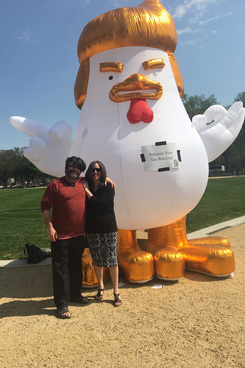 Tax March outside the U.S. Capitol in Washington, D.C., on April 15. (Photo: Pam Stephens)
Tax March outside the U.S. Capitol in Washington, D.C., on April 15. (Photo: Pam Stephens)
Thousands of people protested in more than 150 Tax March rallies around the country Saturday to demand that President Donald Trump release his tax returns, and it all started with a tweet by Vermont Law School professor Jennifer Taub. Well, hers and a similar Tweet by comedian Frank Lesser.
On the heels of the record-setting Women’s Marchs in January, Taub and Lesser independently proposed that people take to the streets April 15 to push Trump to follow through on his campaign promise of making his returns public, a vow he has since backed away from.
People liked the idea of a Tax March, and soon Taub and Lesser were coordinating with others to stage marches across the United States. Organizers say that 25,000 attended the main rally in Washington this weekend, with another 45,000 in New York alone. The marches even had an official mascot: the large inflatable chickens with sweeping combovers that bear a striking resemblance to the hair style of a certain Oval Office occupant. (It turns out the chickens were manufactured in China to coincide with the Year of the Rooster, but were left unused after Trump’s rhetoric on China softened.)
We caught up with Taub on Tuesday to discuss how a tweet blossomed into a movement, and where the Tax March goes from here. Her answers have been edited for length and clarity.
This all started with an off-the-cuff Tweet back in January. Did you ever imagine it would turn into a movement?
Absolutely not. I’m fully amazed, happy and really proud of us all coming together for this event.
Which march did you attend?
I’m on the Tax March Executive Committee. I helped organize the D.C. march, so I was down in D.C.
 Michael Kuch, left, and Jennifer Taub, right, in Washington, D.C., on April 14. (Courtesy photo)
Michael Kuch, left, and Jennifer Taub, right, in Washington, D.C., on April 14. (Courtesy photo)
What was that experience like?
It was wonderful. I had not attended that many protests in my lifetime. Back in the late 1980s, I went to Washington for a pro-choice march. That was the only protest I had been to in Washington. I did go to the Women’s March, but in Boston. I’m someone who spends more time inside reading and admiring activists from afar. I’ve always been an armchair kind of policy person.
It was a beautiful, slightly overcast morning. We were on the Capitol Lawn in the green room, and we watched our 20-foot chicken get inflated right in front of the Capitol dome, and watched the crowd come in slowly. Suddenly, you look out and it’s 25,000 people. To watch it happen is a beautiful thing.
Tell me how this came about and what your goal was.
It was the Sunday after the Women’s March. I was feeling very buoyant. I was happy that folks turned out in what proved to possibly be the largest protest in American history. I thought there was an opportunity to raise our voices. I was very concerned with what I saw in this incoming president, and I was also concerned that we had a single party in charge of all three branches of government. To me, at that moment before I sent that tweet out, I saw this fourth branch of government—we the people—stepping up and speaking out. I felt this populist moment happening.
Then I saw on Twitter that Kellyanne Conway said on television that the president was not going to release his tax returns and that people didn’t care. I found that really arrogant and untrue. It bothered me because I felt the biggest concern about this presidency was corruption. Was this someone who was seeking office in order to line his own pockets, or would he be serving the public interest?
Let’s plan a nationwide #DivestDonald and #showusyourtaxes protest for Saturday, April 15 https://t.co/Wo9DY9eEGP
— Jennifer Taub (@jentaub) January 22, 2017




